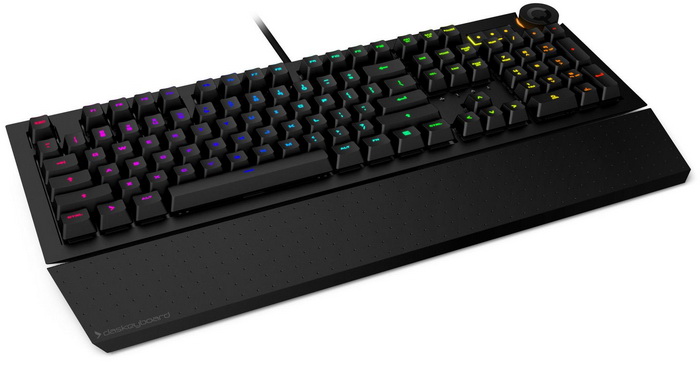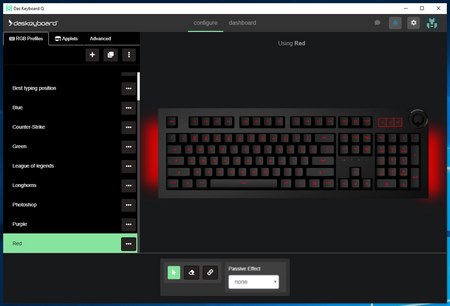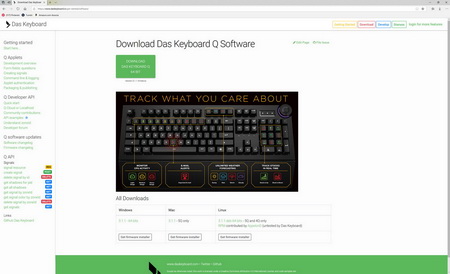INTRODUCTION

Once upon a time the one thing you had to decide when heading out to get a brand-new keyboard was your available budget since the sole difference between models was build quality (sometimes not even that, just brand name). Today however as all of you know things are vastly different and so leaving out your available budget (perhaps still the most important factor) you also need to know what type (membrane or mechanical) and model of switches (Cherry alone has 12 different models currently), illumination color (single and/or RGB), length/factor (full size or tenkeyless) and extra features (like dedicated media controls, macro keys and USB port/s) you'd like your keyboard to have. Das Keyboard recently took things one step further with their brand-new smart cloud connected keyboards and after reviewing the rather impressive X50Q model a while back today and after almost 2 months of testing our review of the 5Q is finally ready.
Das Keyboard, a brand of Metadot, makes high-quality mechanical keyboards. The company is headquartered in Austin, Texas and is dedicated to delivering innovative technology products to increase productivity. Created in 2005, Das Keyboard has been praised by major media outlets, techie magazines, geeks and regular people who use and rely on keyboards to be productive throughout the workday. For more information, please visit www.daskeyboard.com.
Das Keyboard announced the availability of both the X50Q and the 5Q back in August of this year for a reason, they are very much alike. Both keyboards feature the Gamma Zulu mechanical switches manufactured by the Japanese OMRON (up to 100 million actuations/enhanced brightness mode via USB 3.0/45 grams actuation force), RGB per-key backlight with 6 effects and 10 brightness levels, full N-KEY rollover (NKRO) with 100% anti-ghosting, dedicated media controls, aluminum top panels, 2 meter long braided cables and detachable palm rests. Both keyboards also feature the Q smart alert system which can send notifications of new emails, system resource allocation, weather forecasting, stock trends and more onto the keyboard itself (also supports alerts from IFTTT and Zapier compatible WiFi enabled devices). Aside some aesthetic touches (most noticeably the size of the Q buttons/volume knobs, texture of the keycaps and the palm-rests - clip design plastic for the X50Q and magnetic silicone for the 5Q) key response time is the most important difference between these two keyboards so although the X50Q has 20ms thanks to its analog key detection (RTO) the 5Q has just 1ms ("fastest" electronics in the industry according to Das Keyboard). This may not be a game-breaking difference but for some people the extra reduction in lag could be an interesting feature.
SPECIFICATIONS AND FEATURES

PACKAGING AND CONTENTS
The 5Q arrived inside a orange box that has a partial product picture at the front used to showcase the Q alerts system.

 Das Keyboard lists the main features and specifications of the keyboard on the top and bottom of the box.
Das Keyboard lists the main features and specifications of the keyboard on the top and bottom of the box.
A large product picture located at the rear of the box is also used to showcase the main product features.
The keyboard is safely wrapped inside a cloth cover and several pieces of cardboard.
Along with the 5Q keyboard and its detachable palm-rest you're also getting two stickers, keycap puller and the user manual.
THE 5Q
Measuring 451mm in length, 153mm in width and 32mm in height the 5Q is just a tad more compact compared to the X50Q again by Das Keyboard (without the palm rest).
As expected, the 5Q is also a floating keys design keyboard (easier cleaning and brighter key backlight).
Just like with the X50Q on the top right corner of the 5Q we find the brightness level (10 levels in total), play/pause, next/previous track keys and the Q button/volume control knob.
One thing you may or may not like about the 5Q is the textured paint placed all over the top of the keyboard (probably because this isn't a gaming oriented model like the X50Q).
Again, like the X50Q the 5Q features RGB LED strips on both sides which you can control from within the Das Keyboard Q Desktop software.
Here we see the Gamma Zulu mechanical switches (if you look closely you'll notice that one of the clips of the D cap broke and fell in the switch so be extra careful while removing any caps) which as mentioned in our review of the X50Q are very similar to the Romer-G switches used in Logitech keyboards (all manufactured by OMRON).
Turning the keyboard over we see the company name, two rubber feet and two height adjusters.
These two height adjusters push the top end of the keyboard roughly 12mm from the desk.
Unlike the X50Q the palm rest of the 5Q features a large metal piece which attaches to the keyboard thanks to two small magnets.
With the palm rest attached the width of the 5Q jumps to 233mm.
The two meter long braided cable ends on a single gold plated USB plug.
Q-DESKTOP
The Q-Desktop control software can be downloaded from the official Das Keyboard support page as seen above (remember to create an account with Das Keyboard and login via the Q-Desktop software otherwise some features will not be available to you).
Once you install the software it will detect the keyboard model you're using (X50Q or 5Q) and check for firmware updates (in our case one was available).
The initial tab is almost entirely taken by a large product picture which displays the current RGB mode loaded.




From the Applets tab you can choose to use the Q smart alert system with one of the 13 currently available apps.
Advanced users can use the Zapier and IFTTT services to configure and use custom signals.


11 RGB modes are available for you to choose from the RGB profiles tab.



Of course, you can always create your very own by choosing passive and active effects, colors and the keys you'd like to illuminate (by default the color you choose will apply for the entire keyboard - you can choose individual keys by pressing CTRL and clicking on each key).


Here you can see the minimum and maximum brightness levels for the keys (just like with the X50Q Das Keyboard claims up to twice as much brightness and although that's not something we can measure these are very bright).






Some of the available RGB profiles are showcased above.
AUDIBLE FEEDBACK

Many people ask my opinion on what keyboard they should get for their needs. Some want a “silent” model for use in their living room or even in their bedroom while others ask for a model with good audible feedback for use in the office or for gaming. Because of this I decided to test keyboards by placing our ExTech HD600 vertically over each keyboard (5cm distance) and typing NikKTech a total of 6 times with each (after that the max recorded number - max hold - is placed in the graph). I have to admit that this methodology may not be 100% accurate but it does give a good idea on what you can expect from each model since aside the type of switches used keycaps and keyboard material also matter.
CONCLUSION

Since both the X50Q which we reviewed a while back and the 5Q are very similar keyboards we decided to use the latter for a longer period of time to see if the 1ms feature is actually something which can make a significant difference and the short answer is no, at least not for the most part. In games it's hardly noticeable (if you know what to look for you may be able to notice it in some fast passed titles like FPS and simulators) and while typing it hardly makes any difference since the keys register when pressed (regardless of speed). Now perhaps some professionals may find other uses for this specific feature but my guess is that even though the 5Q is not a gaming keyboard (according to Das Keyboard the X50Q fills that spot) it's professional and serious gamers who will probably be mostly interested in it. Once again since we feel that it may be just a tad early for such features the Q smart alerts and the IFTTT/Zapier integration may not appeal to the majority of consumers and professionals but since their Kickstarter campaign was funded over 5 times over there's certainly an audience for them. Unfortunately, several months after our review of the X50Q Das Keyboard has yet to deliver to consumers and professionals the ability to program the keys of their smart cloud connected keyboards with macros, shortcuts and commands. This is a rather important feature so Das Keyboard informed us they were looking to bring to their Q-Desktop app but as you can all see it's still not here.
The 5Q is currently the flagship keyboard by Das Keyboard so its price tag is set even higher compared to that of the X50Q (current price comparison). To be more specific you are currently required to pay USD199 inside the USA (Amazon.com) and 249Euros inside the EU (Amazon.co.uk) to get your hands on the 5Q Cloud Connected RGB Mechanical Keyboard by Das Keyboard. Just like with the X50Q this is the single largest issue with the brand new 5Q and although once again we expect a good number of potential buyers to be look elsewhere because of it (perhaps one of their non “smart” models) thanks to its build quality and features it’s certainly worth of our Golden Award.

PROS
- Excellent Build Quality (Aluminum Top)
- Gamma Zulu Mechanical Switches (100 Million Actuations / Silent)
- 1ms Response Time (RTO)
- Per Key RGB Illumination With 6 Effects And 10 Brightness Levels
- RGB Side Strips
- Q Smart Notifications (IFTTT / Zapier Compatible)
- Full NKey Rollover (NKRO) With 100% Anti Ghosting
- Dedicated Media Keys
- Detachable Silicone Magnetic Wrist Rest
- 2 Meter Long Braided Cable with Gold Plated Plug
CONS
- Price (For Some)
- Keys Aren’t Programmable (For Now)
- No USB Passthrough

 O-Sense
O-Sense


























.png)

